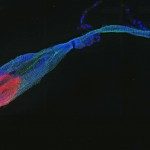Lien vers Pubmed [PMID] – 12809807
Infect. Genet. Evol. 2003 Jul;3(2):125-33
The recent introduction of molecular methods has gained increased acceptance as a powerful tool for epidemiology and phylogeny of tuberculosis (TB). In this investigation, the efficiency of molecular typing using mycobacterial interspersed repetitive units (MIRUs) was assessed on a set of 116 Mycobacterium tuberculosis complex clinical isolates from 11 different geographic origins. The results obtained were compared with spoligotyping and variable number of tandem DNA repeats (VNTRs) typing data. Eighty-nine different MIRU profiles were obtained on the sample studied. Spoligotyping- or VNTR-defined clusters were split into subclusters by MIRU typing. Conversely, almost all of the clinical isolates clustered by MIRUs were shown to belong to spoligotyping-based defined clusters. The calculation of the discriminative power by the Hunter-Gaston index (HGI) for VNTR, spoligotyping and MIRU typing gave the values of, respectively, 0.959, 0.965 and 0.988, showing the high discriminative power of the MIRUs. The allelic diversity of the sample was calculated for each of the MIRU-VNTR loci; five MIRU loci (MIRU nos. 10, 23, 26, 31 and 40) were “highly discriminant”, four (MIRU nos. 4, 16, 24 and 39) were “moderately discriminant”, and three (MIRU nos. 2, 20 and 27) were “poorly discriminant”. Among the three complementary VNTRs (exact tandem repeats ETR-A, ETR-B and ETR-C), ETR-A was the most discriminant locus. A combined numerical analysis of spoligotyping, VNTR and MIRU typing results partly corroborated a recently hypothesized evolutionary scenario for the M. tuberculosis complex. M. canettii would be the first branch to have diverged from a common M. tuberculosis complex ancestor. The East-African Indian (EAI) clade could be the first family to have diverged thereafter. A third branching separated a M. africanum-M. bovis clade, followed by a node separating Beijing versus non-Beijing M. tuberculosis. The Beijing clade was distinct from the Central Asian 1 (CAS1) family. Among non-Beijing strains, branches such as the Latin-American and Mediterranean (LAM), X and Haarlem clades diverged later. In conclusion, the results obtained show the congruence between clades defined by spoligotyping, and MIRU-VNTR, and underline the potential of these methods for M. tuberculosis phylogeny reconstruction. We also conclude that MIRU typing is a very promising method that may be used in a “two PCR-based” genotyping strategy, in conjunction to conventional epidemiological investigations.
